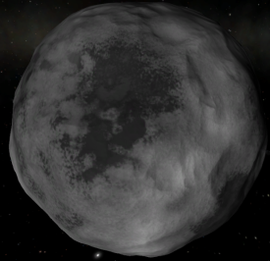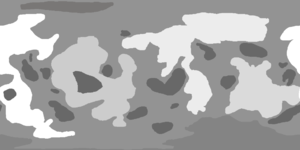Ike
| Ike | ||
| Ike as seen from orbit. | ||
| Moon of Duna | ||
| Orbital Characteristics | ||
| Semi-major axis | 3 200 000 m [Note 1] | |
| Apoapsis | 3 296 000 m [Note 1] | |
| Periapsis | 3 104 000 m [Note 1] | |
| Orbital eccentricity | 0.03 | |
| Orbital inclination | 0.2 ° | |
| Argument of periapsis | 0 ° | |
| Longitude of the ascending node | 0 ° | |
| Mean anomaly | 1.7 rad (at 0s UT) | |
| Sidereal orbital period | 65 518 s | |
| 3 d 0 h 11 m 57.9 s | ||
| Synodic orbital period | 65 766.7 s | |
| Orbital velocity | 298 - 316 m/s | |
| Longest time eclipsed | 2 153 s | |
| Physical Characteristics | ||
| Equatorial radius | 130 000 m | |
| Equatorial circumference | 816 814 m | |
| Surface area | 2.1237166×1011 m2 | |
| Mass | 2.7821615×1020 kg | |
| Standard gravitational parameter | 1.8568369×1010 m3/s2 | |
| Density | 30 231.777 kg/m3 | |
| Surface gravity | 1.10 m/s2 (0.112 g) | |
| Escape velocity | 534.48 m/s | |
| Sidereal rotation period | 65 517.862 s | |
| 3 d 0 h 11 m 57.9 s | ||
| Sidereal rotational velocity | 12.467 m/s | |
| Synchronous orbit | Outside sphere of influence | |
| Sphere of influence | 1 049 598.9 m [Note 1] | |
| Atmospheric Characteristics | ||
| Atmosphere present | No | |
| Scientific multiplier | ||
| Surface | 8 | |
| Splashed | N/A | |
| Near space | 7 | |
| Outer space | 5 | |
| Recovery | 5 | |
|
| ||
Ike is a moon and the only natural satellite of Duna. Ike has steep, rocky slopes and no atmosphere. Ike and Duna are tidally locked due to their proximity and Ike's size. This means that Ike is in synchronous orbit around its parent body, and that each body is only visible from approximately half of its partner's surface. (It would be exactly half, but Ike's slightly eccentric orbit creates regions for which Ike can be seen to set and rise. See Libration, below). It is the largest among planetary satellites relative to the size of the planet that it orbits in the Kerbol system.
An encounter with Ike is quite likely when approaching Duna, provided the player's trajectory is near the plane of Ike's orbit. This is because Ike's sphere of influence is very high relative to the semi-major axis of its orbit — in fact, no other moon in the game has a larger SOI-to-semi-major-axis ratio and no other moon is as close in mass to its parent – Ike has about 6% the mass of Duna.
Stationary orbit around Ike is not possible — it would require an altitude of 1 133.90 km, outside of Ike's sphere of influence. However, since Ike and Duna are tidally locked to each other, a spacecraft in stationary orbit around Duna will see Ike in a near stable, non-rotating position, as if it were in a stationary Ike orbit. It is not perfectly stationary as Ike has both a non-zero orbital eccentricity and a very small orbital inclination.
Although Duna is the game analog for Mars, Ike does not seem to represent Phobos or Deimos. The Duna-Ike system could be interpreted as an analog of Pluto-Charon – in the real solar system, no moon has a mass as similar to its parent body as Ike.
Contents
In-game Description
| “ | Ike is a relatively large, grey object occasionally seen orbiting Duna. Scientists have postulated that Ike is seemingly perfectly positioned to sneakily interfere with any object that presumes to come orbiting near its parent. | ” |
Geostationary properties and libration
Ike's orbit keeps it directly above a short range of Duna longitudes. The average Duna longitude where Ike tends to stay directly above in the sky (at the Zenith) is 3 degrees east, but the exact longitude oscillates between about 0 degrees and 6 degrees east due to the eccentricity of Ike's orbit. This eccentricity also makes Ike appear to grow slightly larger and smaller to an observer on the surface of Duna. The latitude for which Ike is in the Zenith also oscillates between 0.2 degrees south and 0.2 degrees north due to Ike's orbital inclination, making Ike appear to rotate upwards and downwards as viewed from the surface, but due to the extremely small orbital inclination, this effect is nearly imperceptible. These phenomena together are known as libration. Due to the oscillation in Ike's position above the horizon, areas from 90°W to 84°W and 90°E to 96°E on Duna can observe Ike rise and set at least partially across the horizon, as can any areas north of 89.8°N or south of 89.8°S
Traveling from a 50 km Duna orbit to a 10 km Ike orbit requires approximately 435 m/s of delta-V.
Topography
Ike is extremely rocky. Its tallest points are 12.75 km above its lowest, giving it an elevation range over 3 times that of the Mun despite the fact that the Mun has a 54% wider radius and 137% more surface area. The increased elevation and smaller size result in many steep slopes and make landing quite difficult. The bottoms of valleys are among the flatter, safer landing locations.
Ike lacks any visible impact craters. This is strange considering that it has no atmosphere and isn't much smaller than the Mun which has plenty of craters.
The ground is dark grey, notably darker than that of other rock moons like Mun, and sprinkled with large rocks when terrain scatters are on. Sometimes the ground doesn't reflect sunlight, which generates an effect where if someone is looking at the ground, it seems to be nighttime; only looking up shows that it is actually daytime.
Biomes
Ike has 8 biomes. It is one of three bodies (the other being Moho and Kerbin) that has their own North and South Pole biome.
Biome list
|
Easter Eggs
Reference: Do not taunt with the happy fun ball! Before 0.18, there was a boulder locked in a polar orbit, roughly 100 cubic meters, with green bands and a monolith. It had no gravitational pull (and was not affected by gravity). It had a flawed collision box, so an attempted landing always resulted in an explosion of some kind. It was called 'The Magic Boulder' which was its official name as shown in the log entry "Ship crashed into magic boulder". An example video has been made by YouTuber Scott Manley, who maintained a distance of 8 meters long enough to give viewers an excellent picture of the object. Since 1.1.3, the Magic Boulder will instead randomly appear as a (purely cosmetic variation of) an "asteroid". Also Ike has a pointy pole. Danny2462 does a video on this (https://www.youtube.com/watch?v=-e5SGynBJ4Y) where he searches the Magic Boulder (see above) but (in the map view) he sees a pointy pole. He lands near it and then EVA's his only Kerbal out and then he goes there and the pole flips the camera, then messes with it, then kills the Kerbal.
Reference Frames
| Time warp | Minimum Altitude |
|---|---|
| 1× | Any |
| 5× | 5 000 m |
| 10× | 5 000 m |
| 50× | 10 000 m |
| 100× | 25 000 m |
| 1 000× | 50 000 m |
| 10 000× | 100 000 m |
| 100 000× | 200 000 m |
Gallery
Changes
- Added biomes
- Initial release











